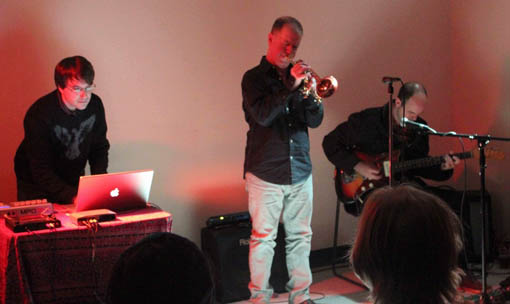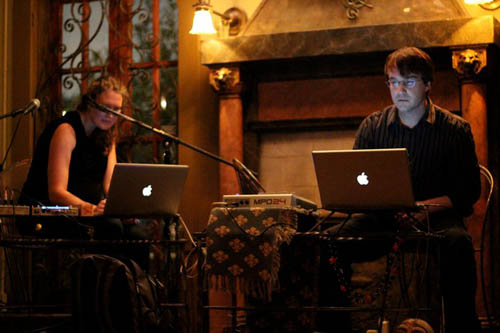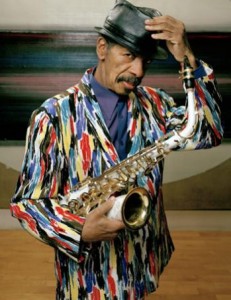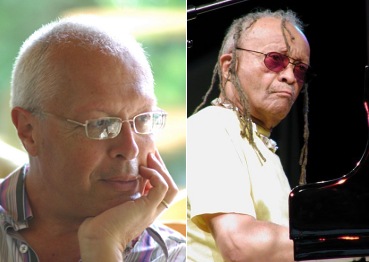 [Ed. note: Composer and S21 regular Chris Becker sat down recently with the one and only Matana Roberts. I told him I’d love to feature his interview, and so here it is: ]
[Ed. note: Composer and S21 regular Chris Becker sat down recently with the one and only Matana Roberts. I told him I’d love to feature his interview, and so here it is: ]
………………
Saxophonist, composer, fanzine writer, and blogger Matana Roberts is the current artist in residence at Issue Project Room (NYC) where she is developing and presenting in a series of concerts material for her “large scale…sound narrative” COIN COIN. COIN COIN might be described as a multi-movement composition utilizing composed, improvised, and pre-recorded music along with elements of theater (projections, candles, chains) to give voice to a complex family history that extends from Louisiana to at least three other continents. Matana – a Chicago native – combines her Midwestern roots (including the influence of the Association for the Advancement of Creative Musicians of which she is a member) with a very Southern-styled “collage” compositional technique to realize performances that (in Matana’s words) “…create an atmosphere where the people witnessing it feel enveloped into the experience.” Those words certainly describe the two COIN COIN performances I myself have witnessed, the most recent being last week (September 30) where Matana, on alto saxophone, clarinet, and vocals, was accompanied by drummer and percussionist Mike Pride.
Her recent CD The Chicago Project (2008) is a wonderfully varied collection of original compositions featuring Chicago musicians guitarist Jeff Parker (Chicago Underground Trio, Nicole Mitchell’s Black Earth Ensemble), bassist Josh Abrams (Josh Abrams Quartet) and drummer Frank Rosaly (Ken Vandermark) and special guest tenor saxophonist Fred Anderson. We talk a little bit about this recording in the interview that follows.
I first became aware of Matana’s work via her blog (Shadows of a People now called In The Midst of Memory). What I like about her writing is its immediacy and honesty whether she is providing details about her family ancestry or reacting to this country’s current confusions regarding race, gender, and class. Matana’s will to give voice to her experience as a creative artist in the 21st century, as well as to the history of her Southern, African, and European ancestors is one of the things that inspired me to reach out to her for this interview.
Please note: This interview was conducted and edited just before the untimely and tragic passing of Issue Project Room founder Suzanne Fiol. Matana is certainly not the only artist to speak highly of Suzanne, and I would like to express my sincere condolences to everyone who knew and loved her.
Chris Becker: As a composer and bandleader, can you talk about how you select musicians for a recording date or a Coin Coin performance? Do you compose with specific musicians in mind or do you go about the search and selection after the fact?
Matana Roberts: I like to compose with specific people in mind when I have the luxury to do so. Since I have been working on COIN COIN now for about 5 years as I re edit the work, I can pick and choose amongst sound makers that mean a lot to me not only as musicians but also as friends and almost honorary family. I put together The Chicago Project with every musician that is on that record in mind. I wanted it to be a very specific document about my Chicago roots and development and all of the people involved are people who made it possible for me to play at the level I am playing now.
The only exception on that record would be Frank Rosaly– Frank showed up in Chicago right after I left, but I wanted him on the record because I felt he represented the positive new influx of creative direction Chicago has been getting in the last 10 years or so, and I also just liked him as a person. I’m more interested in musicians as people first, sound makers second. If they are not compassionate and open and considerate as people, that means that their sound output will (to me) be just as cold as their probable personality in my opinion.
CB: Not to take anything away from the other musicians you play with, but one of the many exciting things about your CD The Chicago Project is the sound of Jeff Parker’s guitar playing alongside the sound of your alto saxophone. You each have a very distinctive sound that blends as well as contrasts with the other throughout the tracks. What do you anticipate musically from Jeff when he is playing with you?
MR: For whatever reason I have yet to figure out why Jeff and I have a very special musical connection that has always been apparent even in the little time we have played together. Maybe it’s because he has such big ears. He listens to some of everything and deals with the process of sound in so many different capacities – in collaborative groups, groups he leads, as a deejay. He’s one of the busiest sidemen in creative music and so I just feel like he internalizes so much that allows him to connect with someone weird like me in a really empathetic and eerily intuitive sense. He’s also just has an incredible big heart, the best laugh ever (Nicole Mitchell is a runner up to this though-her laugh comes from such an amazing wellspring of sound!) and speaks with such kindness about so many things, and knows how to speak on them with a tasteful brevity that I wish I could access more often… (more…)






 After moving from New Orleans to New York City, I managed to stay connected to keyboardist/composer Lawrence Sieberth thanks to the Internet and email, keeping him posted on my music activities. My first memory of Larry is hearing him on piano performing his 1995 tribute concert Booker and Black at the Contemporary Arts Center which celebrated the music of New Orleans musicians pianist James Booker and drummer James Black with projected visuals by artist Jon Graubarth (Jon created the artwork for my CD
After moving from New Orleans to New York City, I managed to stay connected to keyboardist/composer Lawrence Sieberth thanks to the Internet and email, keeping him posted on my music activities. My first memory of Larry is hearing him on piano performing his 1995 tribute concert Booker and Black at the Contemporary Arts Center which celebrated the music of New Orleans musicians pianist James Booker and drummer James Black with projected visuals by artist Jon Graubarth (Jon created the artwork for my CD 
 Wolfgang Grajonca that is, who is better-known to us old hippies as Bill Graham, the late impressario of the Fillmores East and West and the man who brought the music to a thousand purple-hazed nights of our misspent youths. Graham taped and saved everything and you can stream hundreds of full concerts free (downloading costs a little money) at a site called
Wolfgang Grajonca that is, who is better-known to us old hippies as Bill Graham, the late impressario of the Fillmores East and West and the man who brought the music to a thousand purple-hazed nights of our misspent youths. Graham taped and saved everything and you can stream hundreds of full concerts free (downloading costs a little money) at a site called  [Ed. note: Composer and S21 regular
[Ed. note: Composer and S21 regular